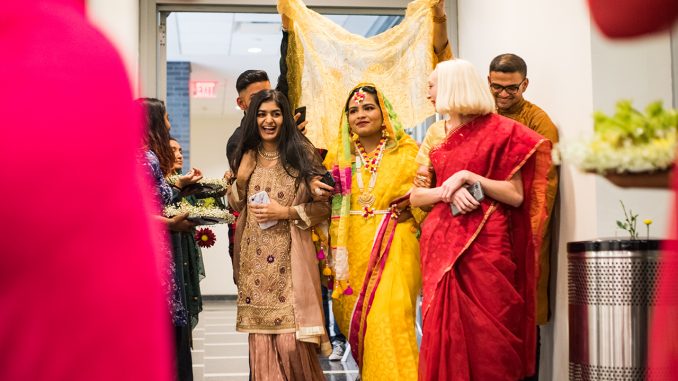
Morgan Residence Hall was buzzing on Nov. 1 with sounds of celebration. Smells of savory and sweet food filled the air, leading guests down an aisle strewn with tea lights and rose petals toward a night of music and games.
Kaafila: The Indian Students’ Organization at Temple University and the Bangladeshi Students Association came together to host Holud x Diwali, an event that combined and celebrated important aspects of Bengali and Indian cultures.
BSA organized a mock wedding for the Gaye Holud, also known as Haldi, which is a part of an elaborate series of celebrations making up a Bengali wedding. Kaafila organized events for Diwali, the five-day Hindu festival of lights, which followed the mock wedding.
Entering the event, guests received a traditional Bengali wedding welcome — a tika, or dot of gold on the forehead, a bag of candy, a piece of mithai, or a traditional sweet, and a freshly cut flower, all before being showered in rose petals.
BSA Secretary and junior human resources major Tasmiah Kamal played the bride, walking down the aisle adorned in a yellow sari, bangles, necklaces and chains of flowers. The henna on her hand symbolized good luck for the couple, Kamal said.
The event was an important way to help students reconnect with their heritage, Kamal said.
“Many people aren’t in touch with the culture here, especially first-generation American kids who are very into American culture,” she said. “So just to bring this celebration here, to give them a taste of how life is back home, for them to enjoy, that’s why we did this.”
Kamal’s “groom” Rithik Gangwani, a senior sports recreation and management major and Kaafila member, said he hopes international students enjoyed the celebration.
“I’m an international student from India, so for me coming here and doing an event like this makes me feel at home,” he added. “It’s exactly like how it is at home, just in a different location, so you don’t feel the difference.”
Guests went up to Kamal and Gangwani and put the turmeric paste on their faces, another part of a Haldi ceremony.
Sarina Ahmed, the BSA vice president and graduate pharmacy student, said the purpose of this part of the ceremony is to make the bride and groom “feel brighter” on their wedding day.
“That is actually my favorite part because it’s a little quirky, and it’s interactive,” Ahmed added.
To kick off the Diwali festivities of the evening, Ahmed, Gangwani and others performed to Bollywood Hits including “Desi Girl” and “First Class.”
Anmol Gupta, a senior risk management and insurance major and president of Kaafila, said Diwali is a celebration of the triumph of good over evil.
Guests enjoyed dishes, like chicken tikka masala, naan bread, chole, and desserts, like gulab jamun, before they flocked to the dance floor to dance to favorites like “Aankh Marey” and “Kar Gayi Chull.”
Ahmed taught dance moves to those unfamiliar with the music. She loved the opportunity to share her culture, she said.
“It’s so important to have this at Temple, not only for Bengali or Indian people to join together and celebrate together, but to expose it to quote-unquote outsiders because it’s bright, it’s fun, and it’s for everyone,” Ahmed said.
Another part of Diwali is playing games of chance. Guests played a game known as Tambola, or housie, a game similar to bingo.
Senior neuroscience and psychology major Aaswari Laxmikat Gharat said the games are played because Diwali is also the time people pray to the goddess of wealth, Lakshmi.
“I really loved the smiles everyone had,” Gupta added. “I saw so many people of all different races coming together and celebrating the Haldi and celebrating Diwali,”
Gharat also hopes people see more out of the culture than just festivals.
“The Indian culture is much more,” Gharat said. “It’s getting together and sharing the love and compassion we have for each other.”


Be the first to comment